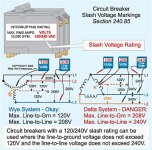LJBMatt
Member
Not really my problem, but my city has asked for help. They have two 15 hp 230V 3-phase motors pumping make up water into their water tower. The incoming power is 230V 3-phase with a "high leg", i.e. one leg is 220V and two other legs are 120V. They are using GE drives (AF300's I believe) rated at 15hp, 230V to operate the pumps. Apparently the saleman was good and said these drives would operate without incident. They frequently (daily) have, surprise, Overvoltage faults, and sometimes have over or under current problems as it seems the drives don't like the non-uniform incoming power.
My initial idea would be to double the size of the drives and run off of 230 1-phase (2 low legs) and use the drive to change to 230 3-phase. The city also has been told by a few power conditioning vendors that they could not solve their incoming power issues for the drives unless they are oversized. Anyone out there have any experience with this type of 3-phase power that could lend me some advice?
My initial idea would be to double the size of the drives and run off of 230 1-phase (2 low legs) and use the drive to change to 230 3-phase. The city also has been told by a few power conditioning vendors that they could not solve their incoming power issues for the drives unless they are oversized. Anyone out there have any experience with this type of 3-phase power that could lend me some advice?




